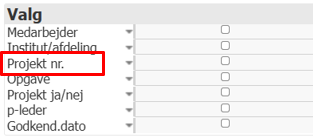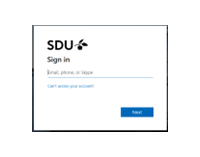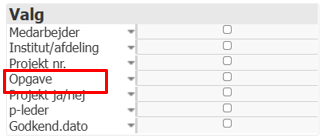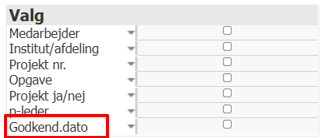HIRING PROCESS IN RELATION TO TIME REGISTRATION
Before a position is advertised, a decision must be made: Is this person a self-organiser or not?
As a result of the new law on time registration and its implementation at SDU, a decision must be made at the beginning of a recruitment process as to whether the person appointed to the position can be considered a self-organiser. Read the guidance further down on this page: GUIDELINES FOR MANAGERS ON SELF-ORGANISERS.
As a consequence, SDU HR has adjusted the process for recruitment with and without advertisement for VIP, DVIP and TAP managers, and the job advertisement templates and recruitment request form have been changed.
The change entails extra attention in relation to passing on information in SDU HCM for employees at faculties and departments who are responsible for recruitment and for HR consultants in SDU HR.
Description of the process for new hires with and without adverts
PowerPoint presentation from the webinar on 14 May 2025 (in Danish only)
Recording of the webinar on 14 May 2025 (in Danish only)
GUIDANCE FOR MANAGERS ON TIME REGISTRATION
You can read all about the target group for time registration on the page:
Purpose and framework for time registration
Here you will also find the principles for registration of working hours at SDU.
Working hours are part of the working environment and SDU is committed to ensuring a good working environment.
As a manager at SDU, it is important that you ensure that employees covered by the law register and approve their working hours. As an employer, SDU must be able to document compliance with the rules.
The human consequences of working too much over a long period of time can result in physical, psychological and social challenges for the employee, which is why it is important to be aware of both time-registering and self-organising employees.
The financial consequence of exceeding the law on time registration for employees who register working hours can result in fines for the university. This can be very expensive for SDU, and we must avoid this.
Your tasks as a manager of time recording employees are to:
- Create a balance between working life and tasks for your employees
- Maintain an ongoing dialogue with your employees
- Ensure compliance with working hours regulations
- Monitor both time registration and your employees approval in mTIME and take action if the employee is close to exceeding the law on time registration (see below)
The law on time registration - registration of working hours
|
||
|
|
PHASE |
DESCRIPTION |
NAVIGATION |
Open mTIME |
Access mTIME via: Log in with your SDU work email and password if you are asked to do so (e.g. if you use your own equipment) When you use an SDU computer, you will automatically be logged into mTIME |
|
Select unit |
Select the ‘Overview’ tab on the left side Select ‘Show as: unit’
You now have an overview of all your employees |
|
Select period |
Select ‘month/year’ at the top |
|
View approved/unapproved timesheets |
Only employees need to approve timesheets - not the manager Click ‘Yes’ if you want to see approved timesheets Click ‘No’ if you want to see unapproved timesheets Click ‘All’ if you want an overview of all employees. Approved timesheets are marked with a tick |

|
View specific employee |
Tap on the employee name The timesheet for the employee will now be visible at the bottom of the window
|
 |
|
||
|
Start by finding your own institute/section. |
PHASE |
DESCRIPTION |
NAVIGATION |
Find one of your employees |
Search under ”Medarbejder”
|
 |
Find your institute/section |
Search under ”Institut/afdeling”
|
|
Find a specific project number |
Search under ”Projekt nr.”
|
 |
Find a specific activity |
Search under ”Opgave”
|
|
Find all users on a specific project |
Search under ”Projekt ja/nej”
|
 |
Find all employees belonging to
|
Select under ”p-leder” ONLY used for employees with the agreement ‘Project time registration’ |
 |
Sort the list based on approval date |
Search under ”Godkend.dato” |
|
Select period |
Select "a year" and "a week" The period is displayed 17 weeks back |
 |
Employees marked ind red |
Name marked in red means that the employee has not approved their timesheet |
 |
Locking selection criteria/filter |
Example, it is possible to lock the year:
|
 |
PowerPoint presentation in English by May 23, 2025:
Manager's guide - Time registration
Recording of the webinar on May 23, 2025, on the role of the leader (in Danish)
GUIDANCE FOR MANAGERS ON SELF-ORGANISERS
According to the Working Hours Act (Arbejdstidsloven), SDU must ensure that all employees covered by the Act register their working hours. As an employer, SDU must be able to document compliance with the rules.
Not all employees are covered by the obligation to register their working hours. So-called self-organisers can be exempted from registering their working hours based on a specific and individual management assessment. This is a management decision.
This guide is used for the management’s assessment of who can be exempted from registering their working hours.
Working hours are part of the working environment and SDU is committed to ensuring a good working environment.
The human consequences of working too much over a long period of time can result in physical, psychological and social challenges for the employee, which is why it is important to be aware of both time-registering and self-organising employees.
Your tasks as a manager of self-organising employees are to:
- Create a balance between working life and tasks
- Maintain an ongoing dialogue with your employees
-
Keep an eye on your employees' working hours and ensure compliance with the law on time registration
Self-organisers are defined as follows:
- Employees whose working hours are not measured and/or predetermined due to the specific characteristics of the work performed
- Employees who can determine their own working hours; for instance, when it comes to
- Employees with management functions
- Employees with the power to make independent decisions
The definition is supplemented by the Danish Employee and Competence Agency’s interpretation of the rules, which have been further implemented at SDU:
- Employees with management functions (primarily personnel management and in special cases academic management functions) can be exempted if they work in such a way that they organise their own time in general.
- The English version of the directive mentions ‘academics’ as possible self-organisers, and based on this it can be assumed that employees in the academic job structure can be exempted.
- Teaching obligations are not considered an obstacle to being a self-organiser.
- If an employee (including managers) is subject to fixed working hours, they cannot be exempt. Fixed working hours means that the employee is required to be at work during a certain period of time, for example from 8.00 to 15.30.
- Employees covered by an on-call programme cannot usually be exempt.
- To some extent, assumptions can be taken into account, such as ‘the head of department A is exempt, therefore head of department B can also be exempt’.
- The possibility for exemption is not based on the employee’s level in the organisation, but on the content and form of the work performed.
- Self-organisers have a high degree of freedom with regard to organising their own working hours.
- The manager's right to manage and distribute the work remains unchanged.
The employees who are exempt from registering their working hours will receive a supplement to their employment certificate regarding this.
It follows from section 14(1) of the Danish Universities Act that the day-to-day management of the university is carried out by the rector within the framework established by the university board. The rest of the management fulfils its tasks as delegated by the rector.
SDU’s statutes contain a detailed description of the delegations to the Pro-Rector (section 15), the University Director (section 16), the deans (section 17) and the heads of department (section 21).
Section 02.02 of SDU’s accounting instructions describes the management structure as follows:
- Management level 1:
- The members of SDU’s Executive Board; that is, the Rector, the Pro-Rector, the University Director and the deans of SDU’s five faculties
- The members of SDU’s Executive Board; that is, the Rector, the Pro-Rector, the University Director and the deans of SDU’s five faculties
- Management level 2:
- The heads of the faculty administrations
- The heads of department
- The heads of division in the Central Administration
In addition, a dean can appoint one or more managers/heads at a faculty at management level 2, who report directly to the dean, to have a similar authorisation, such as employed vice deans.
In addition to managers at management levels 1 and 2, SDU has managers at management levels 3 and 4, defined as managers with personnel responsibilities who report directly or indirectly to a head of department, a head of division or a head of faculty administration (management level 2). In SDU’s HCM system, information about managers at the four management levels is registered.
SDU’s management will make a specific individual assessment of whether an employee with management functions is a self-organiser. It is a prerequisite for exemption that the person in question is employed in a position with management authority, such as a classified managerial position, as a senior consultant with personnel management or in other positions with management authority.
In the assessment, SDU’s management will determine whether the individual manager, due to their position, responsibilities and tasks, can make an independent decision on registering their working hours, see further below.
Guidance on TAP manager exemption:
|
Job category |
Assessment according to job content |
Impact of the assessment |
|
Managers at management level 1; Rector, Pro-Rector, University Director, deans |
These managers can determine their own working hours and make independent decisions |
Following a specific and individual assessment, managers at management level 1 will generally be self-organisers. |
|
Managers at management level 2; heads of department, (employed) vice deans, heads of division and heads of administration |
These managers can determine their own working hours and make independent decisions |
Following a specific and individual assessment, managers at management level 2 will generally be self-organisers. |
|
Managers at management level 3 and 4, such as heads of secretariat, team leaders, etc. |
These managers can often determine their own working hours or organise their time in general, but this depends largely on the person’s function, tasks (content and form of the work performed) and individual agreements.
Furthermore, some of these managers may be required to be at the workplace for a set amount of time (fixed working hours) and therefore cannot be self-organisers. |
After a specific and individual assessment, managers at management levels 3 and 4 will generally be self-organisers.
If a specific and individual assessment of the manager’s function, tasks (content and form of the work performed) and individual agreements shows that the manager cannot organise their time in general and/or if they are subject to fixed working hours, they cannot be exempted. |
The job structure for academic staff at universities contains an exhaustive description of the job categories that can be used for academic staff at SDU.
At SDU, the most commonly used job categories are: research assistant, PhD student, postdoc, assistant professor, associate professor, professor, clinical associate professor, clinical professor, teaching assistant professor and teaching associate professor.
Academic staff members with management functions are assessed according to the academic position.
SDU’s management will make a specific individual assessment of whether the individual academic staff member (VIP) is a self-organiser. In the assessment, SDU’s management will determine whether the individual VIP – for instance, as a result of academic freedoms – can make an independent decision on the determination of their working hours, see further below.
Link to (in Danish) Executive order on job structure for academic staff at universities
Link to the University Act and SDU's declaration on academic freedom
Guidance on VIP and DVIP exemption:
| Job category |
Assessment according to job content |
Impact of the assessment |
|
Principal positions; Professor, associate professor on a promotion programme, associate professor/senior researcher, tenure track assistant professor, assistant professor, PhD student |
For these positions, due to the specific characteristics of the work performed, the number of working hours cannot be measured or predetermined and employees can determine their own working hours or organise their time in general. As a rule, employees in principal positions are self-organisers. For certain employees in principal positions, it will also apply that they are employees who can make independent decisions or employees who have managerial functions. Teaching obligations are not an obstacle to being a self-organiser |
Following a specific and individual assessment, employees in principal positions will generally be self-organisers. If a specific and individual assessment of the employee’s function, tasks (content and form of the work performed) and individual agreements means that the number of working hours, due to specific characteristics of the work performed, can be measured or predetermined, or that the employee cannot organise their time in general, they cannot be exempted.
|
|
Other, general positions (monthly salaried employees)
Research assistant, teaching assistant professor, teaching associate professor, postdoc, senior advisor |
For these positions, due to the specific characteristics of the work performed, the number of working hours cannot be measured or predetermined and employees can determine their own working hours or organise their time in general. For some senior advisors, it will also apply that they are employees who can make independent decisions or employees who have managerial functions. Teaching obligations are not an obstacle to being a self-organiser. |
Following a specific and individual assessment, employees in principal positions will generally be self-organisers. If a specific and individual assessment of the employee’s function, tasks (content and form of the work performed) and individual agreements means that the number of working hours, due to specific characteristics of the work performed, can be measured or predetermined, or that the employee cannot organise their time in general, they cannot be exempted. |
|
Other, general positions (hourly paid employees, D-VIP) Assistant lecturer, part-time lecturer |
For these positions, it applies that employees can make independent decisions and determine their own working hours in general. Teaching obligations are not an obstacle to being a self-organiser. |
Following a specific and individual assessment, employees in these positions will generally be self-organisers. If a specific and individual assessment of the employee’s function, tasks (content and form of the work performed) and individual agreements means that the number of working hours, due to specific characteristics of the work performed, can be measured or predetermined, or that the employee cannot organise their time in general, they cannot be exempted. |
|
Other positions within health science Clinical professor and clinical associate professor |
For these positions, due to the specific characteristics of the work performed, the number of working hours cannot be measured or predetermined and employees can determine their own working hours or organise their time in general. For some employees in these positions, it will also apply that they are employees who can make independent decisions or employees who have managerial functions. Teaching obligations are not an obstacle to being a self-organiser |
Following a specific and individual assessment, employees in these positions will generally be self-organisers. If a specific and individual assessment of the employee’s function, tasks (content and form of the work performed) and individual agreements means that the number of working hours, due to special features of the work performed, can be measured or predetermined or that the employee cannot organise their time in general, they cannot be exempted |
Guidance on the exemption of Academic staff according to the job structure of the Bachelor of Engineering and Export Engineering programmes
|
Job category |
Assessment according to job content |
Impact of the assessment |
|
Assistant professor/associate professor, guest engineering lecturer, guest engineering associate professor and amanuensis |
For these positions, due to the specific characteristics of the work performed, the number of working hours cannot be measured or predetermined and employees can determine their own working hours or organise their time in general.
Teaching obligations are not an obstacle to being a self-organiser. |
Following a specific and individual assessment, employees in these positions will generally be self-organisers.
If a specific and individual assessment of the employee’s function, tasks (content and form of the work performed) and individual agreements means that the number of working hours, due to specific characteristics of the work performed, can be measured or predetermined, or that the employee cannot organise their time in general, they cannot be exempted. |
GUIDANCE FOR DTAP AUTHORIZERS
Note!
To be an authorizer in mTIME, you must have authorizer rights and the authority to approve payroll documents in CRM.
|
||
|
The mTIME process is as follows: 1. The student will send their monthly sheet in for approval. ___________________________________________________________________________ Info If a student sends in a timesheet containing more than one analysis/project number. The hours will be sent for approval at the corresponding analysis/project number. All hours on all the different analysis/project numbers on a given timesheet must be approved before the timesheet arrives in the payroll department. |
|
EXPLANATION |
NAVIGATION |
|
Access mTIME via: Log in with your SDU work email and password if you are asked to do so (e.g. if you use your own equipment) When you use an SDU computer, you will automatically be logged into mTIME
|
 |
|
Press “Approval” under the “Summary” header on the lefthand side. |


|
|
1: Search field, here you can search for names, projects, numbers, and so on. 2: Date field used to navigate between months. 3: By clicking on the small plus button the timesheet will expand for a detailed view. Close it again with the small minus button. 4: To verify, authorize, decline, or recall you must press the corresponding button. 5: Opens when a button from step 4 is pressed. A comment is only necessary if a timesheet is being declined. Press continue to approve. |

|
GUIDANCE FOR PERSONNEL MANAGERS FOR EMPLOYEES REGISTERING PROJECT HOURS
Coming up...







